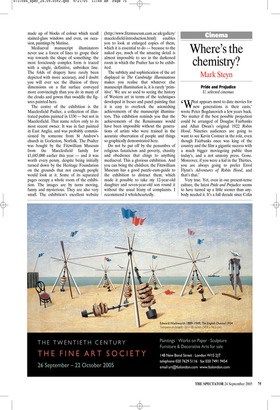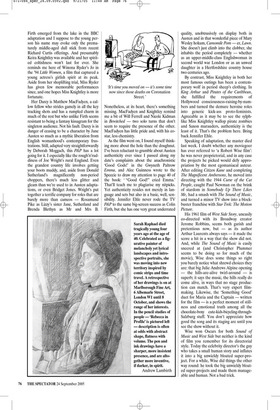Where’s the chemistry?
Mark Steyn
Pride and Prejudice U, selected cinemas ‘What appears most to date movies for new generations is their casts,’ wrote Peter Bogdanovich a few years back. ‘No matter if the best possible projection could be arranged of Douglas Fairbanks and Allan Dwan’s original 1922 Robin Hood, Nineties audiences are going to want to see Kevin Costner in the role, even though Fairbanks once was king of the country and the film a gigantic success with a much bigger moviegoing public than today’s, and a not unnoisy press. Gone. Moreover, if you were a kid in the Thirties, you are always going to prefer Errol Flynn’s Adventures of Robin Hood, and that’s that.’ Very true. Yet, even in our present-tense culture, the latest Pride and Prejudice seems to have turned up a little sooner than anybody needed it. It’s a full decade since Colin Firth emerged from the lake in the BBC adaptation and I suppose to the young person his name may evoke only the prematurely middle-aged dull stick from recent Richard Curtis offerings. And presumably Keira Knightley was available and her spirited coltishness won’t last for ever. She reminds me here of Winona Ryder’s Jo in the ’94 Little Women, a film that captured a young actress’s girlish spirit at its peak. Aside from her shoplifting trial, Miss Ryder has given few memorable performances since, and one hopes Miss Knightley is more fortunate.
Her Darcy is Matthew MacFadyen, a callow fellow who strides gamely in all the key tracking shots and has a rumpled charm in much of the rest but who unlike Firth seems resistant to being a fantasy kissagram for the singleton audience. Not his fault. Darcy is in danger of ceasing to be a character by Jane Austen so much as a mythic liberation from English womanhood’s contemporary frustrations. Still, adapted very straightforwardly by Deborah Moggach, this P&P has a lot going for it. I especially like the rough’n’ruddiness of Joe Wright’s rural England. Even the grandest country life involves getting your boots muddy, and, aside from Donald Sutherland’s magnificently non-period choppers, there’s much less glitter and gleam than we’re used to in Austen adaptations, or even Bridget Jones. Wright’s put together a terrific company for roles that are barely more than cameos — Rosamund Pike as Lizzy’s sister Jane, Sutherland and Brenda Blethyn as Mr and Mrs B. Nonetheless, at its heart, there’s something missing. MacFadyen and Knightley remind me a bit of Will Ferrell and Nicole Kidman in Bewitched — two solo turns that don’t seem to require the presence of the other. MacFadyen has little pride and, with his costar, less chemistry.
As the film went on, I found myself thinking more about the hole than the doughnut. I’ve been reluctant to grumble about Austen authenticity ever since I passed along my date’s complaints about the anachronistic ‘Good Gods!’ in the Gwyneth Paltrow Emma, and Alec Guinness wrote to the Speccie to draw my attention to page 40 of the book: ‘ “Good God!” cried Emma.’ That’ll teach me to plagiarise my nitpicks. Yet authenticity resides not merely in language and sets but also in a basic, well, sensibility. Jennifer Ehle never rode the TV P&P to the same big-screen success as Colin Firth, but she has one very great underrated quality, unobtrusively on display both in Austen and in that wonderful piece of Mary Wesley hokum, Camomile Porn — er, Lawn. She doesn’t just climb into the clobber, she inhabits the period completely — whether as an upper-middle-class Englishwoman in second world war London or as an unwed daughter in a Hertfordshire country house two centuries ago.
By contrast, Miss Knightley in both her most famous outings has been a contemporary wolf in period sheep’s clothing. In King Arthur and Pirates of the Caribbean, she fulfilled the requirements of Hollywood consciousness-raising-by-numbers and turned the demure heroine roles into generic kick-ass proto-feminists. Agreeable as it may be to see the sylphlike Miss Knightley wallop pirate zombies and Saxon marauders, authenticity is the least of it. That’s the problem here. Bring back Jennifer Ehle.
Speaking of adaptation, the master died last week. I doubt whether any moviegoer has ever referred to ‘a Robert Wise film’: he was never proprietorial, and in any case the projects he picked would defy appropriation by the most egomaniacal auteur. After editing Citizen Kane and completing The Magnificent Ambersons, he moved into directing with the 1944 Curse of the Cat People, caught Paul Newman on the brink of stardom in Somebody Up There Likes Me, had a smash with The Sound of Music, and turned a minor TV show into a blockbuster franchise with Star Trek: The Motion Picture.
His 1961 film of West Side Story, uneasily co-directed with its Broadway creator Jerome Robbins, seems both garish and pretentious now, but — as its author Arthur Laurents always says — it made the score a hit in a way that the show did not. And, while The Sound of Music is easily sneered at (and Christopher Plummer seems to be doing so for much of the movie), Wise does some things so right you barely notice what shrewd choices they are: that big Julie Andrews Alpine opening — the hills-are-alive twirl-around — is superb; it says the music, the hills really do come alive, in ways that no stage production can match. That’s very expert filmmaking. Likewise, the ‘Something Good’ duet for Maria and the Captain — written for the film — is a perfect moment of stillness and emotional truth among all the chocolate-boxy cute-kids-bicycling-throughSalzburg stuff. You don’t appreciate how good the song and its staging are until you see the show without it.
Wise won Oscars for both Sound of Music and West Side but neither is the kind of film you remember for its directorial style. Today the celebrity director’s the guy who takes a small human story and inflates it into a big unwieldy bloated super-project. For a while, Wise did things the other way round: he took the big unwieldy bloated super-projects and made them manageable and human. Not a bad trick.

































































 Previous page
Previous page